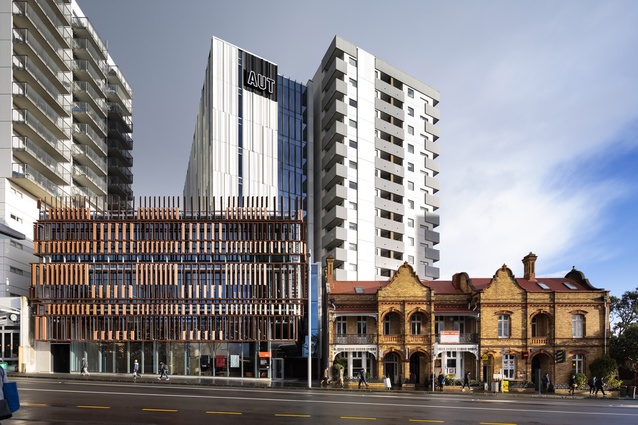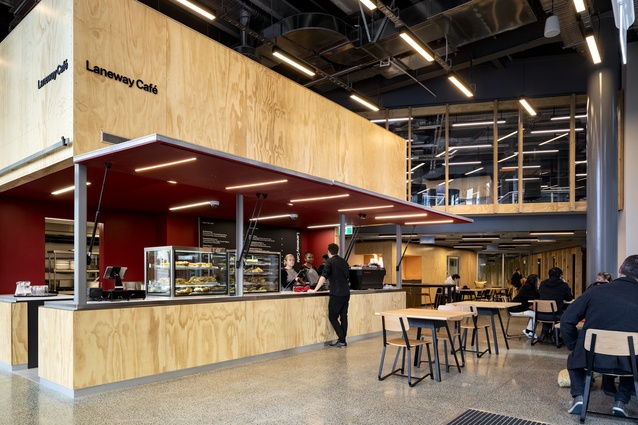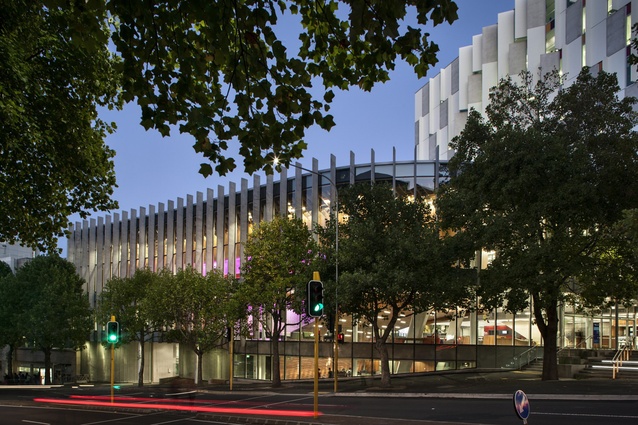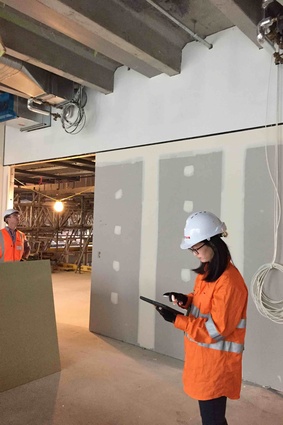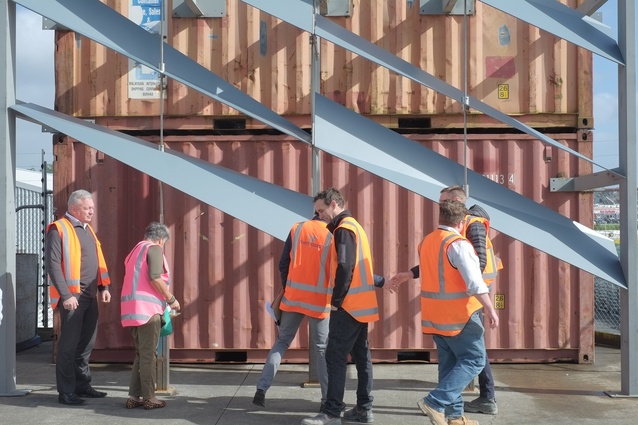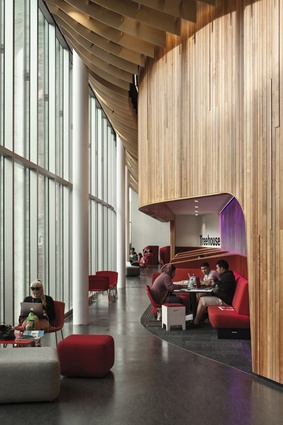Diversity talks: Jasmax roundtable
Jasmax’s most recent Auckland University of Technology building, Ngā Wai Hono, houses the engineering, mathematics and computer sciences departments; along with being designed by a team that comprised men and women from many cultural backgrounds, the building itself fosters togetherness and cross-disciplinary interaction in the hope of innovation. Ashley Cusick speaks with a few of the team members behind this new project.
Our roundtable includes Chris Scott, Marianne Riley and Barbara Van Zyl. Chris was the lead architect for the Ngā Wai Hono project and pulled together a team that was made up of women and men from several different nationalities. Marianne is a senior architect with Jasmax who worked on the project and is also leading the firm’s Diversity and Inclusion Strategy. Barbara was the project delivery architect, and she has many years’ experience working on site for large projects in a male-dominated environment.
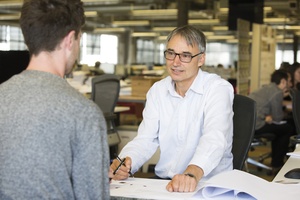
Ashley Cusick (AC): Chris, you’ve been with Jasmax for well over a decade now. What have you seen change in terms of cultural diversity, either within Jasmax or just with the way you work with clients?
Chris Scott (CS): Within Jasmax, there’s a lot more awareness of the importance of diversity. It’s really obvious, I guess, when you come in to our offices these days. The welcome we had for our new CEO recently was a pretty graphic example of that. There was a great powhiri for him; it was quite powerful and that wouldn’t have happened 15 years ago when I started.
In terms of projects, I’ve spent a lot of my time at Jasmax working on AUT projects, and diversity in all of its forms has always been very important to that client, so we’ve had a lot of discussions about it. AUT is the largest Pasifika university in New Zealand, and it has a very strong Māori presence.
AC: How was the theme of diversity considered when creating the Ngā Wai Hono building?
CS: It’s probably not expressed just as cultural diversity but as diversity of individuals: across cultures, genders, everyone. Everyone’s different. How do you celebrate that? How do you support that?
It’s something that we’ve considered since we first started working with AUT and it has carried through all our projects with them. When we did the Sir Paul Reeves building, which was quite a transformational building for AUT, we knew that it was really important for universities that students stay on campus. We wanted to make students feel comfortable because the longer they stay, the better they do.
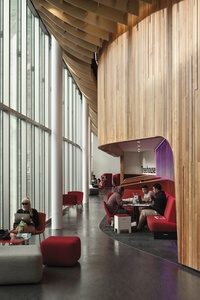
We actually made a matrix of different profiles – introverts, extroverts, large groups, small groups, short stay, long stay. We looked at different furniture arrangements to suit those groups and looked at the spatial arrangements within the buildings and how to play off the character of those spaces.
When that building was occupied, it was really obvious how well that strategy worked. We started to see different cultural groups using different spaces more. For instance, in the Treehouse, there are often large groups of Indian students or Pasifika students there. It’s a group space, but it’s quiet; it’s not right out in the open.
AC: What were some benefits of having cultural diversity, or gender diversity, within the team itself for this project?
CS: Does anyone else want to talk? Shall I give my answer first and then you can pipe in?
Marianne Riley (MR): In the spirit of diversity, yes.
CS: The starting point for creating the team was looking at the needs of the project: the team structure and the skills and experience levels required. So, I built a team around the diversity of skills that were required to complete the project. Because of that, diverse skills and viewpoints are there from the start. It was only once the team was assembled that I looked around and noticed that over half the team was women. It wasn’t created on that basis at all.
Barbara Van Zyl (BVZ): We also had quite diverse age groups in the team: our oldest member was 91. I think that is quite refreshing to see, because that kind of inclusion contributes to the wellbeing of the project.
AC: Perhaps the better question is, what benefits have you experienced from the diversity within Jasmax in general?
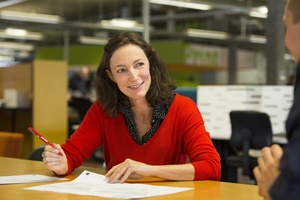
MR: I think it brings different solutions to things, different ways of doing things and different voices as well. It probably needs to be acknowledged that this has changed significantly in the last ten years as well. When I was working on the Grafton medical school between 2007 and 2011, I was the only female on that project. Then, coming on to the Ngā Wai Hono team, it was at least half male/half female, potentially more females.
There has been a significant shift of older, more senior women coming back into the workforce and excellent, young female graduates being hired. We’ve had a real rebalancing of the workforce.
That is becoming evident in projects like this where it’s a very complex project, it needs a lot of engagement with the client in terms of talking things through and the specialization of spaces, and having a gender balanced team was really helpful. Different ways of working are represented and that means that you can address all facets of the client’s needs.
CS: Because the client themselves is diverse, usually. One thing that I have noticed that has changed in the industry as a whole is that architecture is a long path – a young architect is someone who is under 45, I think – that’s probably, in the past, reduced the number of women in large firms. Historically, a lot of women architects have chosen to balance family life with working in small practice from home.
The building industry can be a reasonably brutal place, or, it has been in the past. But, the nature of the whole industry now is much more gender diverse, and that makes it a more inviting place for women to come back to.
MR: I joined 11 years ago, and part of the reason that I came here was I knew that Jasmax was a female-friendly place to work: we had flexibility in the way we work. We now have this cohort moving up and supporting each other. I don’t think raising children is a female-only issue, but there is something very supportive about having people who understand what it’s like to drop a child off, race in to work, be answering queries and all sorts of things.
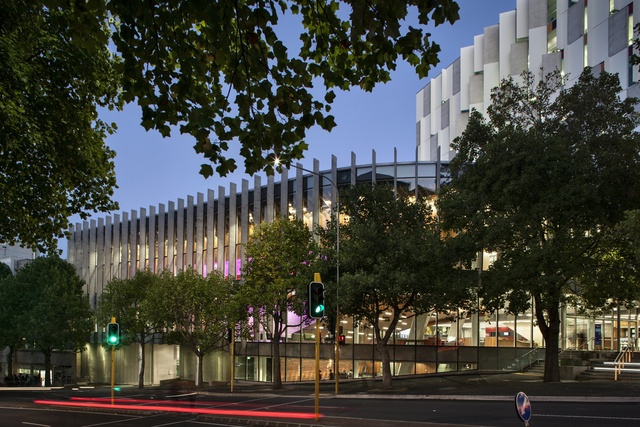
AC: So raising a family is a challenge, perhaps particularly for females, but are there any other challenges that one might face in their career due to their cultural background or gender?
MR: Unconscious bias is a challenging area. I think it is important to realise that the beliefs we hold about ourselves and the beliefs others hold of us are both part of the picture. That’s an area for us to constantly work on and examine how we work together. Bringing awareness to that is something that is crucial, because it is something that has affected particularly females and different cultural groups in terms of what we think we can and can’t do.
AC: I suppose, for tertiary education, diversity is particularly important. For example, with an engineering building, there is a push to get more diversity within that industry. So, having a diverse group designing the building probably helps create inviting spaces for people of different groups.
CS: That was part of the research and briefing that went into the Ngā Wai Hono building. We looked at other universities and found that particularly engineering and computer-based science both have a much lower than average ratio of women across the board. Thinking about that environment from a diverse viewpoint is probably going to help that building in the future in terms of being open to more women.
MR: The academic focus for the building was to be more cross-disciplinary. The idea was to bring together engineering, computing and mathematical sciences to find unique advantages in the space inbetween those crossovers. That idea of bringing together diverse disciplines to cross-pollinate is an exciting one.
CS: And the nature of the building, because it is very expressive of what happens in it, is about using the building as a learning tool. That brings a purity to it. In a way, that makes it gender neutral. It’s not about pre-conceptions of what engineering is; it’s more about what engineering actually is.
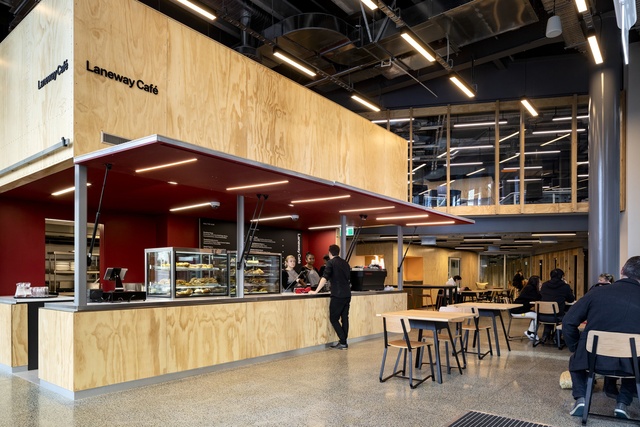
AC: What does equality mean to you? It seems that you are already putting diversity at the fore of your practice, but what could be improved upon in the industry – because the ideal looks different to different people?
BVZ: I do still think it is a male dominated industry out there, actually.
MR: Yes.
CS: It is.
BVZ: With this project specifically, we had a male-dominated consultant team; we were probably the only consultants who had females engaged in the project work. The project management team was all male, and when we got to site, it was all male. I was probably the only female for the first few months until there was a woman who began directing the crane.
Eventually Annis, an architectural graduate with Jasmax, was instrumental in a lot of the combination and services of the building. I think she grew quite enormously from a young graduate to a confident, young architect because of the experience of being involved in a project where the team was dominated by males.
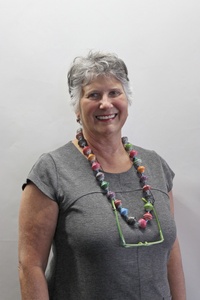
AC: You’ve had a lot of experience being one of few women on site, Barbara. Have you learned anything from those times?
BVZ: From quite early on as a young graduate I was on site with projects I had been involved in designing or documenting and, in all these years, I have never had a really unpleasant experience where I have felt particularly discriminated against.
Part of how you create that team onsite is being able to form a relationship; it is built on a mutual respect at the end of the day. Being onsite is just what you do, and I have always done it.
CS: It is interesting hearing about your experience, because I have had much less pleasant experiences – you know, people’s saliva on my face. It probably does help the culture on site to have women.
BVZ: Yes, diversity changes things. Often, construction sites are full of swearing and rough action and shouting. But, with sites becoming more diverse in themselves, you get big burly personalities, some who are very precise and petite and quiet and often there is some female presence as well. A sense of camaraderie can grow because of that, though.
Having a diverse range of experiences, characters and ideas on a team, it enriches everything, doesn’t it? It is exceptional.
AC: Perhaps as the new wave of graduates and young architects moves up, things will shift even more.
MR: It is happening, but we need to be really deliberate in setting targets around that sort of thing. There are a lot of people of my age that are now principals, but there is still not the equality in male and female representation. I am really passionate about diversity because we need to make the most of each person’s potential, and that means acknowledging their design thinking and talent and the difference in perspective and knowledge and skills that they bring.
It is really important that we are not bringing forward previous ways of doing things. We must take care in the way we foster, engage and enliven our younger people.
We are introducing a Diversity and Inclusion Strategy and that will be broken into three parts: what do we do with our young people, how do we show them a career pathway and, when they are on that career pathway and maybe raising families, how do we keep engaging them and ensuring there is equality.
So, yes, it is very important to be very deliberate about how we do that. Otherwise in another 20 years we might still have the same representation at the senior level.

